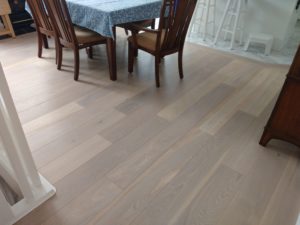 Hardwood pricing can vary dramatically based on type of installation, patterns, artistic work, and various other considerations. What we cover here will be for your more basic installations, including nail down, glue down, floating click, and floating glued tongue and groove. The two main types of hardwood are solid and engineered. Some considerations we will cover include stairs, angles, picture frames for rooms or for smaller items such as fireplaces, and floor prep. We will also cover the importance of quality and timeliness, which are often as important as cost when deciding who to hire to install your hardwood floor.
Hardwood pricing can vary dramatically based on type of installation, patterns, artistic work, and various other considerations. What we cover here will be for your more basic installations, including nail down, glue down, floating click, and floating glued tongue and groove. The two main types of hardwood are solid and engineered. Some considerations we will cover include stairs, angles, picture frames for rooms or for smaller items such as fireplaces, and floor prep. We will also cover the importance of quality and timeliness, which are often as important as cost when deciding who to hire to install your hardwood floor.
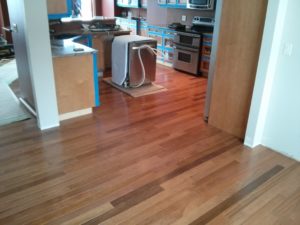
Quality, when we are talking about hardwood floors, is even more important then when we discuss quality for vinyl, carpet or laminate. Hardwood can last longer then almost any other floor, and can bring a home to life like no other flooring. The only challenger to it’s reputation as the most prestigious of flooring is high end tiles.
Whether you purchase hardwood that costs $2.00 a square foot or $200.00 a square foot, you want to make sure all the prep is done properly, or your floor will eventually squeak, boards will separate, furniture will wobble when your floor becomes uneven, and a myriad of other problems can crop up.
The standards for flatness on substrates that hardwood will be installed on are the same as for most other floors, namely 1/8 inch variance over 10 feet, with no more then 1 hill or valley under a 10 foot straightedge. Like all floor prep, this can be a very quick and inexpensive job, or a very expensive one, depending on the quality of the substrate you have to begin with. Many installations over concrete need to be floated with self leveler to get the appropriate degree of flatness.
After substrate preparation, installation begins. If you have a very simple layout, without picture frames, borders, accents and inserts, it often goes smooth from here. The more complex layouts, with bordered rooms, open ended stairs, different colored wood inserts, or patterns like the herringbone pattern that is popular in high end homes, will take significantly more time and require an installer with a lot more skill then your local handyman. Be aware of what you want your floor to look like when finished, and seek out an installer that can reach the standards of quality you set.
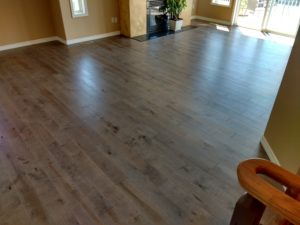 Like all jobs, if you are on a tight time line, you should plan well in advance.
Like all jobs, if you are on a tight time line, you should plan well in advance.
If your time line does not allow for any delays, be sure to have your substrate inspected by the installer at least a few days before installation, to make sure it is within industry standards of flatness before he or she arrives to install your new hardwood floor. If not, you will have a delay to correct it.
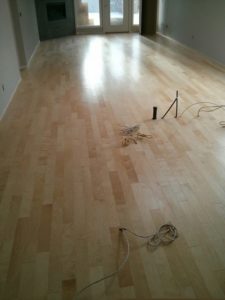
Since there are so many variables in hardwood installation, quotes between jobs can vary dramatically.
All installations of hardwood have a minimum charge, so if you are just having one room done you may not be charged by the square foot. You may also have a price break on jobs over a certain size, for full house installations, or multiple units if you are a contractor or builder.
The variables that affect the price of hardwood installation include, but are not limited to, how big or small the areas are, diagonal or curved walls, picture frames and borders, patterned installations, inserts, and how many areas they connect to. Stairs are considered separately, but a set of stairs can often cost as much as an entire floor of a house, particularly curved or open ended stairs.
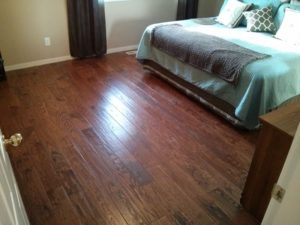
Engineered hardwood has a laminated core with a layer of hardwood on top, while solid hardwood is, as the name implies, wood throughout. Floating wood floors will almost always be engineered hardwood, as will most glue down hardwoods. Nail and staple down can be engineered or solid hardwood. Solid hardwood is normally thicker, and can often be refinished once or twice more then engineered, since it can be sanded down to where the nails or staples are, while engineered can only be sanded down to where the real wood layer on the top ends. In a realistic setting, most people don’t refinish their floor enough to wear through the real wood layer on engineered hardwood, so both are viable options. One advantage to engineered hardwood is it is more stable then solid wood when it comes to movement due to humidity and temperature, as each laminated layer goes an opposite direction.
Current floor removal
Hardwood ideally only goes on top of clean, stable and flat substrates, not old flooring. If you are installing floating hardwood it can go over hard surfaces as long as they meet flatness tolerances, though it may adversely affect the height of your floor where it connects to other material. The cost to remove old flooring varies dramatically, with removal of tile being the most expensive.
Substrate preperation
Making sure your substrate is within flatness tolerance of 1/8” over 10 feet can add to the cost.
Furniture and appliance removal and replacement
Furniture moving is often charged per room, or per hour, appliance moving is often charged per appliance. If anything with gas or water lines need to be moved, you will often need someone qualified to unhook them and hook them back up.
Baseboard removal and replacement
When any floor except carpet is installed, the baseboard needs to come off and be put back on at the new proper height. Whether you put the old baseboard back on or install new ones will change the price by a large factor.
Garbage removal
Garbage and waste removal is included in our quotes, however if you have a garbage bin on site, let us know and we can take that into account when giving you a quote.
Material
The hardwood itself is always separate from installation costs. The underlayment required for floating floors is part of material cost and normally supplied at the same time as the hardwood, if required.
On site finished hardwood
Good Morning Flooring currently does not offer on site finishing of hardwood or refinishing. We do offer installation of unfinished hardwood for subsequent finishing.

